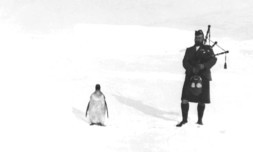When William Speirs Bruce led the second voyage of the Scottish National Antarctic Expedition to Antarctica in 1904, the ship, the Scotia, was trapped in ice for four days.
While the expedition was stuck, scientists continued to take geographical and meteorological observations and measurements.
But the ship’s bagpiper, Gilbert Kerr, also took the time to pose for a photograph on the ice as he serenaded an Emperor penguin.
It was part of an experiment to study the effects of music on penguins.
According to the Royal Scottish Geographical Society, the penguin was tied to a cooking pot to hold him in place.
Perhaps unsurprisingly they found the skirl of the pipes had no discernible impact.
But the famous photograph was sent home as a postcard from Antarctica and inspired a reel ‘The Piper and the Penguin’.
Now a modern day expedition to Antarctica, co-led by Dundee-born adventurer David Crichton Henry, has recreated that iconic image of the Scotia expedition – using a penguin toy – whilst undertaking an “experience of a lifetime” polar adventure of his own.
Mr Henry, 58, a former pupil of Dundee’s Harris Academy who was team historian for the expedition, has just completed a successful trip to the South Pole which honoured the 100th anniversary of Shackleton’s ill-fated Endurance voyage of 1915.
The expedition, led by noted explorer David Hempleman-Adams, set off on November 25.
It aimed to complete ‘unfinished business’ at the South Pole whilst honouring Dundee’s historic connection with the golden age of polar exploration.
Mr Henry, a Fellow of the Royal Geographical Society, and an accomplished adventurer now based in Cambridge, told The Courier: ““It was an experience of a lifetime, but also very hard work. The weather had a key part to play, with unseasonable storms causing us to be delayed both in Chile, awaiting a flight down to Antarctica, and at Union Glacier, waiting for a ‘weather window’ to airlift us and our equipment up on to the polar plateau.
“El Nino weather events probably had something to do with this. For Antarctica, it meant more snow storms than usual and bone chilling temperatures. For us, it added a week or so to our expedition.”
Due to the adverse weather, and with temperatures around minus 40, the team had to cut out some programmed rest days when they eventually made it on to the ice. This meant pushing themselves harder than expected. As a result, they did pick up some injuries, including superficial frostbite to a few of Mr Henry’s fingers.
The 14-strong group walked, skied and “man-hauled” their equipment on sledges for the final leg of Shackleton’s intended route to the South Pole, almost 100 years after Shackleton hoped to do so himself.
In 1915, Ernest Shackleton’s crew was famously forced to abandon their ship, the ‘Endurance’, after it became stuck fast in the grip of the Antarctic pack ice.
Moving from temporary camp to temporary camp, they then drifted with the ice for several months before eventually making land fall on the uninhabited Elephant Island.
From there, Shackleton and five others made a daring, 800-mile sea crossing to South Georgia, in one of the ships lifeboats, called the ‘James Caird’.
This was named by Shackleton after Sir James Key Caird, the Dundee jute manufacturer and philanthropist whose sponsorship had helped finance the expedition.
He also funded the building of Dundee’s Caird Hall.
The modern expedition, called Endurance South Pole 100, was the initiative of descendants of James Wordie, the Scots geologist and chief scientific officer on Shackleton’s ill-fated Imperial Trans-Antarctic Expedition of 1914-1917.
